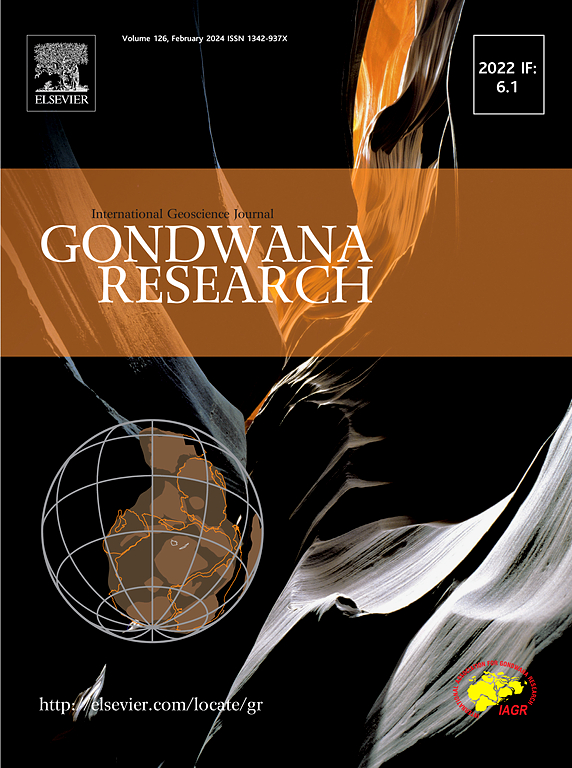Cambrian provenance transition in the southeastern North China Craton and its tectonic implications: Detrital zircon U–Pb–Hf signatures from the Xuhuai region
IF 7.2
1区 地球科学
Q1 GEOSCIENCES, MULTIDISCIPLINARY
引用次数: 0
Abstract
The Cambrian tectonic stability and palaeogeography of the North China Craton (NCC) remain contentious. As the earliest site of Cambrian transgression, the southeastern NCC serves as an ideal location for investigating the geological evolution of the NCC. Provenance analysis through integrated field investigations, elemental geochemistry, and detrital zircon (DZ) U–Pb–Hf isotope analyses of Cambrian clastic sediments in the southeastern NCC reveals three distinct types of DZ age signatures and associated provenance changes, thereby enhancing our understanding of the Cambrian tectonics of the NCC and tracing its potential linkage to Gondwana. DZ age signatures are characterized as three types: (I) double peaks around 2510 and 1850 Ma, with mostly positive and negative εHf(t) values, respectively; (II) minor peaks around 1450, 1150, and 950–750 Ma, alongside the double peaks, exhibiting predominantly positive εHf(t) values; and (III) a scattered array of Mesoproterozoic to early Paleozoic zircons, with minor negative εHf(t) values clustered at 476–518 and 909–1245 Ma. The contrasts between Series 2 Types I and II and the Wuliuan Type III sediments reflect a significant provenance change from the NCC Precambrian basement and/or cover to an exotic magmatic belt to the south, including the coeval Qinling arc. The comparable provenance shifts across the eastern NCC were diachronous during Stage 4 to Wuliuan, governed by transgression processes, Qinling arc-related orogeny, and paleogeographic configurations of alternating uplift and depression. The Cambrian evolution in the southeastern NCC was closely linked to an orogenic process resulting from Shangdan Ocean subduction, challenging the notion of passive tectonism in the NCC. The continental-scale DZ age signatures in the Cambrian unit support the view of the Cambrian NCC as a discrete continental block, paleogeographically separated from Gondwana-affinitive micro-continental blocks and the Gondwana landmass by the Proto-Tethys Ocean.

华北克拉通东南部寒武系物源转换及其构造意义:徐淮地区碎屑锆石U-Pb-Hf特征
华北克拉通的寒武纪构造稳定性与古地理仍有争议。北陆盆地东南部作为寒武系海侵最早的地点,是研究北陆盆地地质演化的理想地点。通过综合野外考察、元素地球化学分析和碎屑锆石U-Pb-Hf同位素分析,揭示了北陆东南部寒武系碎屑沉积物的三种不同类型的DZ年龄特征和相关的物源变化,从而增强了我们对北陆寒武纪构造的认识,并追踪了其与冈瓦纳的潜在联系。DZ年龄特征表现为三种类型:(1)2510和1850 Ma附近的双峰,εHf(t)分别以正、负为主;(II)在1450、1150和950 ~ 750 Ma附近有小峰,与双峰相邻,εHf(t)值以正为主;(III)中元古代-早古生代锆石散列,εHf(t)值在476 ~ 518和909 ~ 1245 Ma之间聚集。二系ⅰ型和ⅱ型沉积物与五流组ⅲ型沉积物的对比,反映出物源由北中系前寒武纪基底和/或盖层向南的外来岩浆带(包括同时期的秦岭弧)的显著变化。第4期至五流期的物源转移是历时性的,主要受海侵作用、秦岭弧造山作用和隆升坳陷交替古地理构造的控制。北克拉通东南部寒武纪演化与商丹洋俯冲引起的造山作用密切相关,对北克拉通被动构造论提出了挑战。寒武纪单元的大陆尺度DZ年龄特征支持了寒武系北陆块作为一个离散大陆块体的观点,在古地理上与冈瓦纳-亲缘微大陆块体和冈瓦纳陆块被原特提斯洋分隔开。
本文章由计算机程序翻译,如有差异,请以英文原文为准。
求助全文
约1分钟内获得全文
求助全文
来源期刊

Gondwana Research
地学-地球科学综合
CiteScore
12.90
自引率
6.60%
发文量
298
审稿时长
65 days
期刊介绍:
Gondwana Research (GR) is an International Journal aimed to promote high quality research publications on all topics related to solid Earth, particularly with reference to the origin and evolution of continents, continental assemblies and their resources. GR is an "all earth science" journal with no restrictions on geological time, terrane or theme and covers a wide spectrum of topics in geosciences such as geology, geomorphology, palaeontology, structure, petrology, geochemistry, stable isotopes, geochronology, economic geology, exploration geology, engineering geology, geophysics, and environmental geology among other themes, and provides an appropriate forum to integrate studies from different disciplines and different terrains. In addition to regular articles and thematic issues, the journal invites high profile state-of-the-art reviews on thrust area topics for its column, ''GR FOCUS''. Focus articles include short biographies and photographs of the authors. Short articles (within ten printed pages) for rapid publication reporting important discoveries or innovative models of global interest will be considered under the category ''GR LETTERS''.
 求助内容:
求助内容: 应助结果提醒方式:
应助结果提醒方式:


